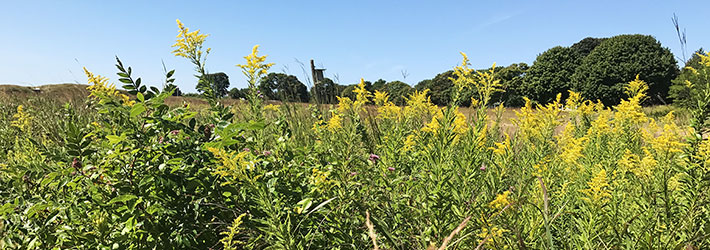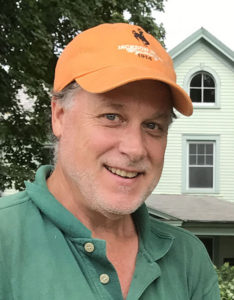
Restored grassland at Parade Grounds.
President’s Message: 2019
In the golden light of autumn, the stunning beauty of our Island is on full display. A dazzling fall migration season produced waves of monarch butterflies in numbers not seen in decades, a record-setting raptor count, and a Nelson’s sharp-tailed sparrow, never before recorded on-Island.

Tom Sargent
This excellent news encourages the Fishers Island Conservancy to continue with initiatives put in place to ensure the environmental health of Fishers Island today and into the future. I am happy to report that our organization is busy and vibrant. Our collaboration with Professors Doug Tallamy and Adam Mitchell continues as they help us tackle the ongoing challenges of coastal habitat restoration and maintenance.
The University of Delaware Invasives Team completed their third summer here and moved up-Island as the Conservancy begins a pilot collaboration with FIDCO on two parcels on the East End. We look forward to doubling the size of the University of Delaware team next spring and summer, since the challenges facing us in the removal of non-native plant species requires an aggressive approach. That being said, the Conservancy also continues to educate individual property owners with over 25 site visits in the last year.
The Demonstration Garden continues to be a resource to those interested in planting appropriate species native to our locale. The garden acts as a “buffet” to our local insect and bird populations and to those species that use the Island as an important stop on the Atlantic Flyway. As most of you know, both bird and insect populations have plunged from 60 to 80 percent, so we must take action to reverse this troubling trend. I am happy to say that the Fishers Island Conservancy is bucking the decline in the Sanctuary and Demonstration Garden, but much more needs to be done. Please use us as a resource for your own gardens and lawns. We are happy to guide you as to best practices.
As the Conservancy enters its 35th year, I am honored to announce that the Demonstration Garden will be dedicated and renamed the John Thatcher Native Garden in memory of John Thatcher, one of the Conservancy’s founders. John was a long-time summer resident of Fishers Island and, when he died in 2017, its longest serving president. John’s love of Fishers Island and all things natural was palpable. Even after he was unable to travel to the Island due to poor health, he kept in touch with us at the Conservancy, imparting valuable institutional advice and concern for the Island he loved so deeply. Please come spend some time in this wonderful garden that John would have adored.
Finally, I would like to make mention that Justine Kibbe, our Conservancy Naturalist, has left Fishers Island. Her beautiful pictures—more than 3000—and her invaluable data illuminated our precious Island home, whether tracking down snowy owls in February, minks darting in and out of ponds, or returning shorebirds in the spring. She also founded the Island Sentinel program, which teaches students the importance of stewardship. We will miss Justine and wish her the best on her new adventure in the Pacific Northwest.
While the Fishers Island Conservancy has had a successful and productive year, the challenges of environmental protection, habitat restoration and educational outreach continue. Now is the time for us to be aggressive in pursuing our mission: to protect and preserve our Island environment. Fishers Island needs us more than ever. Thank you to all who have so generously supported us in the past. I hope you can find it in your heart to do so again. A gift to the Fishers Island Conservancy is a gift to Fishers Island.
For the Conservancy,
Tom Sargent, President